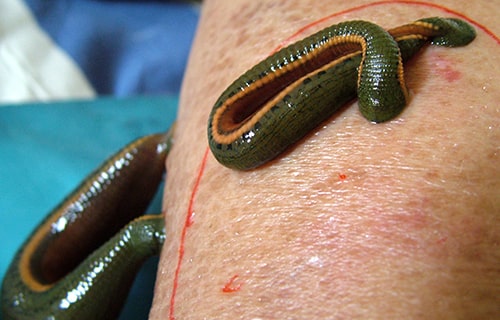
Overview
Raktamokshana therapy is the blood cleansing and purification therapy. It is a therapeutic cleaning process given by Ayurveda. It is one of the essential parts of the Panchkarma healing treatments. Raktamokshana is the prime process of blood detoxification. Ancient Acharya Sushrutha explained Raktmokshana among Panchkarma. It is derived from the two words, “Rakt”, which means blood and “Mokshana”, which means leave.
Thus, Rakt mokshana means to let the blood out. The blood is expelled out from the body to reduce the quantity of toxic substances in the blood borne disorders. However, this therapy is not generally recommended to the patients. This is because; it involves a certain amount of risk factors in the whole cleansing and detoxification processes.
Classifications of Raktamokshana
Raktamokshana is generally of the following two types:
1. Shastra Visravana (Use of sharp instruments for Raktamokshana)
Generally metallic instruments are used to carry out this process. It is further classified into two more categories:
- Pracchana, which means letting the blood pass through several incisions.
- Siravyadha, which is also known as the Venepuncture.
2. Anushastra Visravana (No instrument is used for Raktamokshana)
The metallic instruments are considered for carrying out this procedure. It is further classified into three categories:
- Jalaukavacharana (Leech therapy): which means applying leeches. This is mainly done for the patients with Pitta dosha disorders. There are 12 types of leeches out of them 6 poisonous leeches and 6 are non-poisonous leeches. Non-poisonous leeches are used for bloodletting.
- Alabu (Pitcher gourd): which means creating vacuum and extracting blood through the vacuum using a vegetable, which may be bottle guard or Alabu. This is mainly done for treating Kapha dosha diseases.
- Shrungavacharana (Cow’s horn): which means applying the cow’s horns. This is mainly taken into account for treating the Vata disorders.
Of all the various classified types, Venepuncture of Siravyadha plays the most popular role in carrying out Raktamokshana effectively.
Complications to be Treated with Raktamokshana Therapy
Individuals with aggravated unbalance between the blood (rakt) and Pitta dosha (fire body tumor) and high level of toxicity are recommended as the Raktmokshana therapy. The important complications to be treated with the therapeutic therapy are skin disorders like allergic dermatitis, eczema, sciatica. Some other disorders, which must be treated with Raktmokshana therapy include abscess, edema, swelling and inflammations, uremia, dullness, pericarditis, tonsillitis. Also, this procedure helps in proper functioning of liver, heart and other essential organs of the body.
Procedure of Carrying out Raktamokshana
Raktamokshana, the specialized detoxification process comprises the following steps:
1. Purva Karma
It is carried out in regular periods. It is mainly done for diseases like gout, filariasis, psoriasis, glaucoma, oedema, erysipelas, liver and spleen disorders. Cotton swabs, gauze pieces are some of the proper instruments used to carry out this procedure.
2. Pradhana Karma
The various aspects to be considered during Pradhana Karma are the following:
- Prachhana – This method helps to provide relief from stress, tension and anxiety.
- Siravyadha – According to the disease, the vein is selected. After oleation, sudation, the liquid gruel is injected. The patient either lies down or sits in erect posture.
- Size of puncture – The size should be that of 1 brihi or half barley and in muscular areas, it should be the size of yava.
- Jalaukavacharana – Tiny sized nicks are applied near the affected region. As soon as the blood oozes out, the leech is applied. When the leech sucks, the mouth takes the form of the horse’s hooves. Its neck is then covered using wet cotton. When enough blood is sucked, the leech leaves the area and moves down. In case, it does not leave on its own, turmeric powder is sprinkled on the leech.
- Shringa Yantra – The horns are applied on the fleshy part of the body. In this Yantra the air gets sucked out, which creates a vacuum. The blood oozes out.
3. Paschat Karma
After the pradhana karma is done, dressing is done with a massage gently surrounding the wound. This is done with the help of the medicated oil.
Raktamokshana works as a preventive therapy and curative therapy as well. This therapy in Ayurveda is a partial or a complete treatment depending on the situation.
Best Season for Raktamokshana Therapy
Sharad ritu (Autumn season) is the best season for Raktamokshana therapy. The blood vitiated by pitta, kapha & vata dosha should be removed from Leech therapy (Jalauka), Pitcher gourd (Alabu) and Horn of animals (Shrunga).
Indications of Raktamokshana
- Skin diseases
- Elephantiasis
- Toxic conditions of blood
- Fibroid
- Tumor
- Mastitis
- Conjunctivitis
- Sinusitis
- Liver abscess
- Bleeding disorders
- Gonorrhea
- Swelling
- Herpes
Contraindications of Raktamokshana
- The person suffering from diseases like ascites, anemia, hemorrhoids and dropsy should avoid Raktamokshana.
- Emaciated person should also avoid Raktamokshana.
- During pregnancy Raktamokshana is not preferred.
